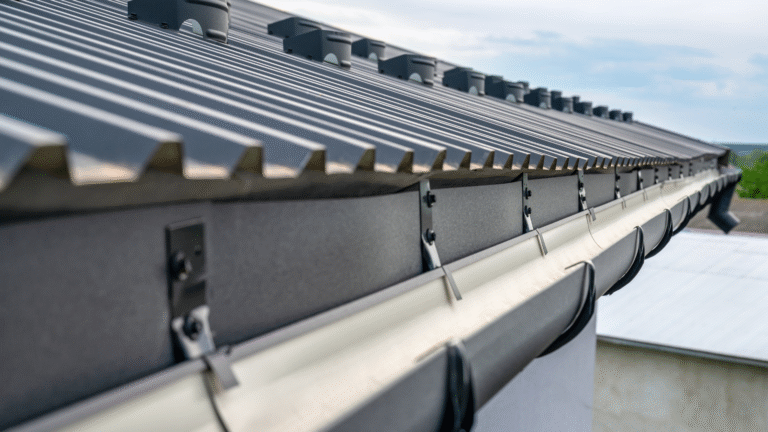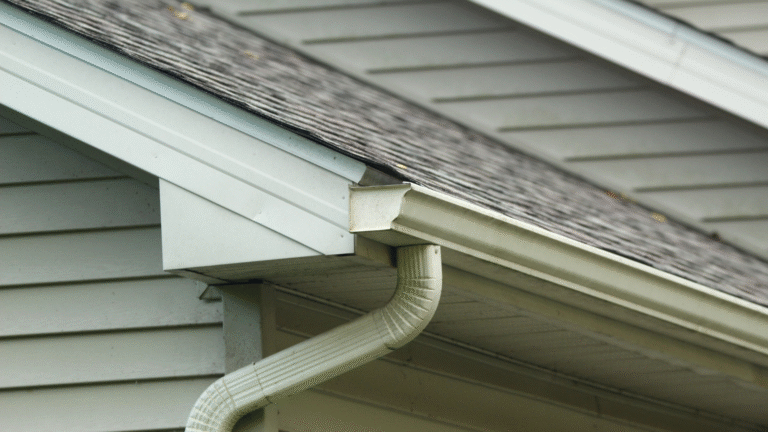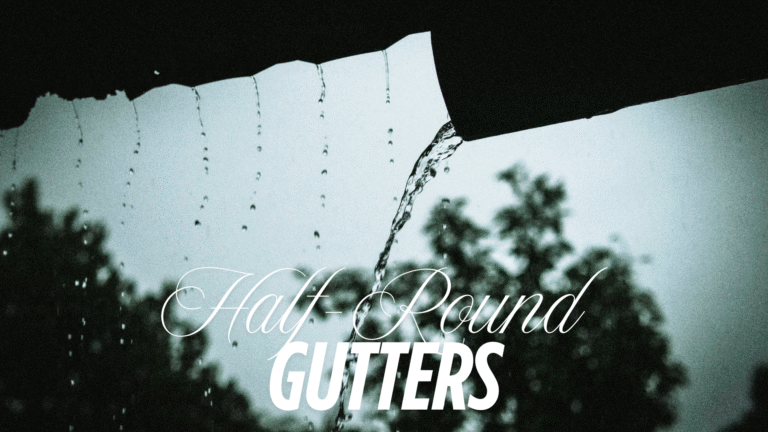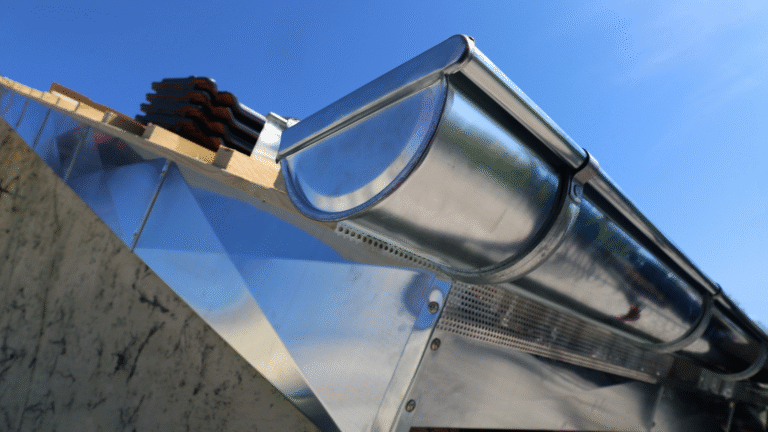A well-maintained gutter system plays a crucial role in protecting your home from water damage, foundation issues, and structural deterioration. Gutters direct rainwater away from the roof, walls, and landscaping, preventing moisture buildup that can lead to mold growth, wood rot, and erosion. When gutters function properly, they safeguard your home’s exterior and interior, reducing the risk of costly repairs caused by uncontrolled water flow. Regular inspections and timely maintenance ensure your gutters remain in top condition, especially during heavy rainfall seasons.
However, when gutters become damaged or clogged, they can no longer channel water effectively, leading to serious home-related issues. Cracks, sagging, or overflowing gutters may lead to basement flooding, siding damage, and even weakened foundations. Ignoring these warning signs can turn minor issues into expensive repair projects. In this article, we’ll explore five clear signs that your gutters need immediate repair to prevent further damage and maintain the integrity of your home.
Table of Contents
The Role of Gutters in Protecting Your Home
Gutters serve as a vital defense system for your home by directing rainwater away from the roof, walls, and foundation. Without properly functioning gutters, water can accumulate on the roof, leading to leaks, wood rot, and mold growth. By efficiently channeling water away, gutters prevent structural deterioration, protect siding from moisture damage, and reduce the risk of costly repairs. Additionally, they help prevent basement flooding and foundation cracks, which can occur when excess water pools around the base of your home.
Beyond structural protection, gutters also play a crucial role in preserving your home’s landscaping. Without a proper drainage system, heavy rain can wash away soil, destroy plant beds, and create unsightly erosion patterns. Well-maintained gutters ensure that rainwater is safely directed away from these vulnerable areas, keeping your yard intact and preventing water-related damage. By investing in regular gutter maintenance and timely repairs, homeowners can protect their property’s longevity and curb appeal.
Sign #1: Overflowing Water During Rainstorms
One of the most obvious signs of gutter damage is water spilling over the edges during a rainstorm. Gutters are designed to channel rainwater away from your home, but when they become clogged, misaligned, or damaged, they fail to do their job effectively. This can lead to a range of serious issues, from water pooling around your foundation to damage to your home’s exterior and landscaping. Addressing overflowing gutters promptly can prevent costly repairs and long-term structural damage.
Causes of Water Spilling Over:
- Clogged gutters: Leaves, twigs, and debris can block water flow, causing overflow.
- Improper gutter slope: If gutters are not angled correctly, water may not drain properly.
- Damaged or sagging gutters: Weak or detached sections can prevent water from flowing smoothly.
- Insufficient downspouts: Too few or improperly placed downspouts can lead to water buildup.
- Ice dams in winter: In colder climates, ice buildup can prevent water from draining, leading to overflow.
- Heavy rainfall exceeding gutter capacity: Some homes may have undersized gutters that cannot handle excessive rainfall.
- Blockages in downspouts: Even if gutters are clear, a blocked downspout can cause water to back up and overflow.
Risks Involved:
- Basement flooding: Overflowing water can seep into the foundation, leading to costly water damage.
- Soil erosion: Excess water can wash away landscaping and weaken the ground around your home.
- Siding damage: Water spilling over can stain and deteriorate exterior walls.
- Mold and mildew growth: Persistent moisture can create the perfect environment for mold.
- Foundation cracks: Excess water pooling around the base of your home can lead to structural issues over time.
- Roof damage: Water backing up onto the roof can lead to leaks and shingle deterioration.
- Pest infestations: Standing water in clogged gutters can attract mosquitoes and other insects.
- Wood rot and fascia board damage: Constant exposure to moisture can cause wooden components of your home to decay.
Sign #2: Sagging or Detached Gutters
Sagging or detached gutters are a clear indication that your gutter system is failing. When gutters pull away from the roofline, they can no longer effectively channel rainwater away from your home. This can lead to uncontrolled water runoff, which damages your siding, foundation, and landscaping. If left unaddressed, sagging gutters may eventually collapse completely, leading to expensive repairs and potential safety hazards. Identifying the causes early and taking corrective action can help prevent long-term structural damage.
What Causes Gutters to Pull Away from the Roof?
- Rust and corrosion: Metal gutters, especially older ones, can rust over time, weakening their structure.
- Loose or missing fasteners: Screws, brackets, and hangers that hold the gutters in place may loosen due to age or weather conditions.
- Heavy debris buildup: Accumulated leaves, dirt, and twigs add extra weight, causing gutters to sag or detach.
- Ice and snow accumulation: In winter, ice dams and heavy snowfall can strain gutters, leading to detachment.
- Water pooling inside the gutters: Poor drainage can cause water to sit inside the gutters, increasing their weight and pulling them away from the fascia board.
- Rotting fascia boards: If the wood behind the gutters rots due to moisture exposure, the gutters lose their secure attachment.
- Improper installation: Gutters that were not installed correctly may lack the support needed to withstand heavy rain and debris.
Structural Damage Risks if Left Unrepaired
- Roof and fascia damage: Detached gutters expose the roof edge and fascia board to excessive moisture, leading to rot and decay.
- Foundation issues: Without properly functioning gutters, water can pool around the base of your home, increasing the risk of foundation cracks and settling.
- Basement flooding: Ineffective water drainage can allow rainwater to seep into the basement, causing water damage and mold growth.
- Exterior wall damage: Water spilling from sagging gutters can stain and weaken siding materials over time.
- Increased pest infestations: Stagnant water in sagging gutters can attract mosquitoes, rodents, and other pests.
- Risk of complete gutter collapse: If gutters continue to sag and detach, they can eventually fall, causing damage to windows, walkways, or anyone standing below.
Sign #3: Visible Cracks, Holes, or Rust Spots
Noticing small cracks, holes, or rust spots on your gutters might not seem urgent at first, but these minor imperfections can quickly escalate into serious problems. Even the tiniest crack can allow water to seep through, leading to leaks that damage your home’s siding, foundation, and landscaping. Over time, repeated exposure to moisture and fluctuating temperatures can cause these flaws to expand, weakening the integrity of the gutter system. Regular inspections can help catch these issues early, before they turn into expensive repairs.
How Even Small Cracks Can Lead to Water Leakage and Damage:
- Water seepage through cracks: Leaks can form at the seams and corners, leading to water damage on siding and fascia boards.
- Worsening with temperature changes: Expansion and contraction due to weather can widen cracks over time.
- Water damage beneath gutters: Persistent leaks can soak the ground below, weakening the foundation and causing basement moisture issues.
- Staining and streaking on exterior walls: Dripping water from cracks often leaves unsightly stains on your home’s exterior.
- Inefficient water flow: Cracks and holes disrupt the water’s path, causing splashing and overflow.
Common Gutter Materials That Degrade Over Time:
- Aluminum: Lightweight and popular, but prone to denting and corrosion if not properly maintained.
- Steel: Stronger than aluminum, but susceptible to rust over time, especially without protective coatings.
- Vinyl: Affordable and easy to install, but vulnerable to cracking in extreme heat or cold.
- Copper: Highly durable and rust-resistant, but may develop holes or weak spots over decades of exposure.
- Galvanized metal: Coated for protection, but the coating can wear off, leading to rust and eventual degradation.
Sign #4: Peeling Paint or Water Stains on Siding
If you notice peeling paint or water stains on the exterior walls of your home, it could be a sign that your gutters are leaking. When gutters fail to channel water away properly, moisture can seep down the sides of your house, causing visible damage over time. These stains often appear just beneath the roofline or along siding seams, indicating that water has consistently run down the walls. Left unchecked, this type of exposure not only mars your home’s appearance, but can also signal more serious underlying issues.
Indications That Gutters Are Leaking and Affecting Exterior Walls:
- Discoloration or streaking on the siding: Brown or dark stains suggest continuous water runoff from faulty gutters.
- Bubbling or blistering paint: Moisture trapped behind paint layers can cause them to lift and peel away.
- Rotting trim or woodwork: Constant water contact can break down wooden elements around windows and doors.
- Visible mildew or algae growth: Moist surfaces attract mold, mildew, and algae, especially in shaded areas.
- Efflorescence on masonry: White, chalky deposits on brick or stone indicate water has been penetrating the surface.
How Water Exposure Leads to Rot and Mold Issues:
- Wood rot in siding and trim: Prolonged moisture breaks down cellulose in wood, weakening its structure.
- Interior water damage: Leaking gutters can eventually lead to moisture intrusion into the walls, affecting insulation and drywall.
- Mold and mildew inside the home: Once water seeps into the walls, it creates a humid environment ideal for mold growth, which can pose health risks.
- Compromised energy efficiency: Wet insulation loses its effectiveness, making your home less energy-efficient and increasing utility bills.
Sign #5: Pooling Water Around the Foundation
Pooling water around the base of your home is one of the most serious warning signs of gutter failure. Gutters are designed to direct rainwater safely away from the foundation, but when they’re clogged, leaking, or improperly installed, water can overflow and settle around the structure. Over time, this consistent exposure to moisture can weaken the soil, compromise the integrity of the foundation, and lead to costly structural damage. If you frequently notice standing water after rainstorms, it’s essential to inspect your gutter system immediately.
The Dangers of Water Collecting Near the Home’s Base:
- Foundation cracks: Excess water can seep into the ground and exert pressure on the foundation, causing it to crack or shift.
- Basement leaks or flooding: Pooling water often finds its way into basements, resulting in water damage and mold growth.
- Soil erosion: Saturated soil can erode over time, undermining the stability of patios, driveways, and walkways.
- Increased pest activity: Moist environments near the home’s foundation attract insects, rodents, and termites.
- Structural settlement: Long-term water exposure can lead to uneven settling, which causes cracks in walls, ceilings, and floors.
- Damage to landscaping: Constant water flow in one area can drown plants and wash away mulch or topsoil.
How Faulty Gutters Contribute to Structural Instability:
- Broken or misaligned downspouts: These can deposit water too close to the foundation, rather than channel it safely away.
- Clogged or overflowing gutters: When water can’t flow freely, it spills over the sides and collects around the home’s base.
- Short or missing gutter extensions: Without proper extensions, downspouts release water too close to the house.
- Improper slope or installation: Poorly installed gutters may direct water toward, rather than away from, the foundation.
How Often Should You Inspect Your Gutters?
To keep your gutter system functioning properly year-round, it’s recommended to inspect your gutters at least twice a year—ideally in the spring and fall. These seasonal check-ups help remove debris from falling leaves, spring blossoms, or storm-related buildup. In areas with heavy rainfall, snow, or lots of surrounding trees, more frequent inspections may be necessary. Regular maintenance ensures that water flows freely and reduces the risk of clogs, sagging, or damage that can lead to costly repairs.
For minor maintenance tasks like clearing out leaves, flushing downspouts, or checking for visible blockages, a DIY approach works well for most homeowners—especially if you have safe access to your gutters. However, if you notice signs of structural issues, such as sagging sections, leaks, or detached downspouts, it’s best to call a professional. Gutter specialists have the tools and experience to handle repairs safely and thoroughly, ensuring your system is secure and ready to handle any weather.
Repair vs. Replacement: What’s the Best Solution?
Deciding whether to repair or replace your gutters depends on the extent of the damage and condition of the system. While small issues like leaks or loose brackets can usually be fixed quickly and affordably, more serious problems—especially those widespread or recurring—may require a full replacement. Understanding the signs can help you make an informed decision that protects your home and saves you money in the long run.
Situation | Repair | Replacement |
Minor Leaks or Cracks | ✅ Can be fixed with sealant or patch kits. | ❌ Not necessary unless widespread. |
Loose or Missing Fasteners | ✅ Re-fastening brackets or hangers can restore stability. | ❌ Only needed if damage is extensive. |
Isolated Rust Spots | ✅ Rust can be treated and repainted to prevent spread. | ❌ Replacement needed if corrosion is widespread. |
Clogged Gutters | ✅ Cleaning and installing gutter guards can solve the issue. | ❌ No need for full replacement. |
Sagging Sections | ✅ Reattaching with stronger hangers may fix sagging. | ❌ Replace if gutters are warped or pulling away completely. |
Aging Gutters (15–20+ years old) | ❌ Repairs may be temporary and less effective. | ✅ Full replacement is often more cost-effective long-term. |
Frequent Repairs Needed | ❌ Constant maintenance indicates deeper issues. | ✅ Better to invest in a new system. |
Improper Slope or Poor Installation | ❌ Difficult to correct with minor fixes. | ✅ Replacement ensures correct alignment and drainage. |
Extensive Visible Damage (cracks, holes, rust) | ❌ Spot repairs won’t be enough. | ✅ New gutters will restore full function. |
Mismatched or outdated materials | ❌ May affect performance and curb appeal. | ✅ Upgrading ensures consistency and modern functionality. |
Water damage despite repairs | ❌ Indicates the system is beyond repair. | ✅ A full upgrade can eliminate ongoing issues. |
Planning exterior renovations | ❌ Old gutters may not suit new designs. | ✅ Replacing gutters can enhance appearance and value. |
Conclusion
Recognizing the early warning signs of gutter damage can save homeowners from extensive and expensive home repairs. Overflowing water during rainstorms, sagging or detached gutters, visible cracks or rust, peeling paint or stains on siding, and pooling water around the foundation are all strong indicators that your gutter system needs immediate attention. Ignoring these issues can lead to structural damage, basement flooding, mold growth, and a weakened foundation—problems that can be both disruptive and costly to fix.
Being proactive with regular inspections and timely maintenance is the best way to extend the life of your gutters and protect your home. Cleaning your gutters seasonally, sealing small cracks, and seeking professional help when needed will help keep your system working efficiently. By staying ahead of these issues, you not only preserve your property’s value but also ensure a safer, more secure living environment for years to come.







